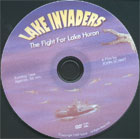
Lake Invaders: The Fight for Lake Huron 2009
Distributed by Green Planet Films, 21 Columbus Ave. Suite 205, San Francisco, CA 94111; 415-377-5471
Produced by John Schmit and Grand Valley State University
Directed by John Schmit
DVD , color, 56 min.
Jr. High - Adult
Biology, Environmental Studies
Date Entered: 06/04/2010
Reviewed by Cliff Glaviano, Coordinator of Cataloging, Bowling Green State University Libraries, Bowling Green, OHThis film is the result of a two year project filmed by Grand Valley State University (MI) students, headed up by director John Schmit, to document the effects of invasive species on the Lake Huron ecosystem. Some 187 invasive species have been introduced into the ecosystem, chiefly from ballast released from ocean-going ships to balance their freight loads, since the Welland Canal allowed ocean freighters to navigate around Niagara Falls into Lake Erie and the western Great Lakes. Invasive species featured in the film include lampreys, alewives, round gobies, zebra and quagga mussels.
Student film crews explore the impact of the invasive species through interviews with biologists and Michigan Dept. of Natural Resources (DNR) personnel. Most on location scenes and interviews are at the Alpena Fishery Research Station or the Station’s research vessel, the Coho II. Grand Valley State University (GVSU) has a very accomplished film and video department and undoubtedly many students involved in the project were trained in the GVSU program. The film is very well done, well-filmed and very well edited. The musical accompaniment is a bit too dramatic for the content, but still the production values are excellent.
The film will benefit from a dictionary of terminology, either in the film itself in future distributions, or linked from the film’s website. Even with fairly good knowledge of the Great Lakes ecosystem from a sport fishing point of view, some knowledge of the invasive species effects in Lakes Erie and Ontario, the viewer may find it difficult to follow some terminologies used by the DNR biologists. Clearly the biologists, the crew, and the director knew what they were talking about, but some terms (“podocastian species” comes to mind as one the reviewer couldn’t transcribe) were quite elusive. If those involved in the film were perhaps a bit too close to their subject, the impact of invasive species is well documented. The DVD features also allows the viewer to follow either the chronology of the invasive species and their impacts, or to follow the DNR research station personnel on the 2008 research cruise of the Coho II. Another feature highlighting how the film was made will be very helpful to those interested in filming similar topics on location. This is a strong film in support of the study of ecosystems and the impacts of invasive species with the caveat that the instructor will have to supplement with his or her expertise ... exactly as it should be.